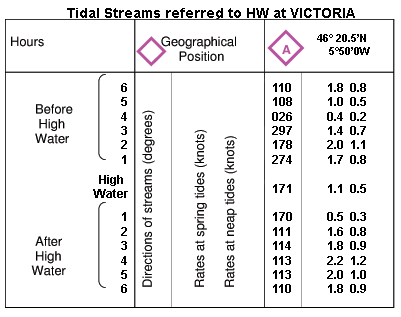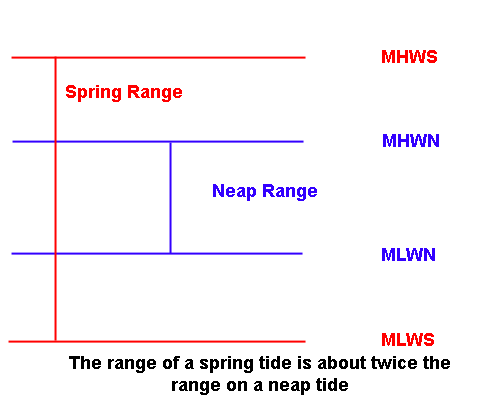Navigation and Chart work - Tidal Information on Charts
TIDAL DIAMONDS
Spread around a chart are magenta coloured diamonds, each with a different identifying letter in the middle.

The letter used has no significance, they are labelled in alphabetical order.
On Training Chart 3, below the title information there is a table which allows us to calculate the direction and speed of the tidal stream at each of these Tidal Diamonds.
See the extract below:

The data in this table is referred to HW at Victoria! So even though the vessel may be in a position many miles from Victoria, we can look up the tidal stream information for this area by knowing the time of high water Victoria.
On Practice Chart 4, you will find the same thing written above the tidal stream table. So even if you are using a chart which does not cover the area of Victoria, the tidal streams are calculated relative to high water at Victoria.
We can do this because the tidal streams follow a pattern throughout the whole area covered by the chart, and the tide in one area is directly influenced by what happens elsewhere.
To read this table:
The first column on the left is the key to the rest of the data. Information is given for six hours before and after high water Victoria at hourly intervals.
The centre column tells us that the three figure numbers in the diamond 'A' column are the direction of the tide in degrees true (measured from north), and the other two sets of numbers are the rates of tide at springs and neaps (we will cover this in more detail later, spring tides run at about twice the speed of neap tides).
The right hand column is the tidal stream information at the given latitude and longitude for each hour before and after high water.
So at Diamond A (South east of Port Fraser in Beaufort Bay), when it is high water at Victoria the tide is running in a direction of 171°T at a speed of either 1.1 knots or 0.5 knots depending upon whether it is a spring or neap tide.
Tidal levels
Below the tidal diamonds table there is a table which gives the levels of the tide at certain times at important points on the chart.
HAT H ighest A stronomical T ide
MHWS M ean H igh W ater S prings
MHWN M ean H igh W ater N eaps
MLWN M ean L ow W ater N eaps
MLWS M ean L ow W ater S prings
The Mean is the average tide. It is a word used frequently in navigation.
MHWS is the average of the highest high tides,
MHWN is the average of the lower high tides,
MLWN is the average of the higher low tides,
MLWS is the average of the lowest low tides.
HAT is the highest tide that can be calculated, this height may be exceeded when the winds are very strong or there are large differences in air pressure.
The range of the tide is amount is rises or falls between high and low tide.

Typically the range of a spring tide is twice that of a neap tide. As the time for the tide to rise or fall between high and low tide does not very much, the rate of the tidal stream is about twice as fast on a spring tide than on a neap.
1)
What is the direction and rate of the tide at Diamond C on chart 3:
A) Three hours before high tide on a spring tide?
B) Three hours after high tide on a neap tide?
Additional Resources:

